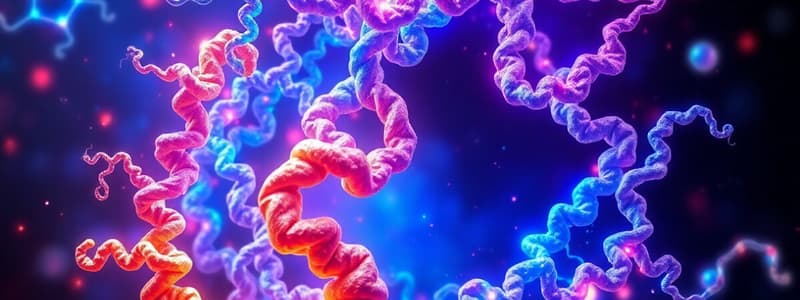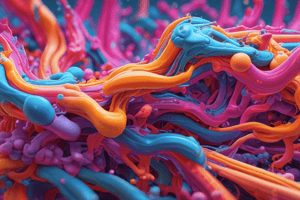Podcast
Questions and Answers
What does Anfinsen's dogma imply about protein structure?
What does Anfinsen's dogma imply about protein structure?
- The sequence of amino acids is irrelevant to the protein's structure.
- The folding process must be understood to predict the final structure.
- A protein's structure can be completely predicted without knowing its sequence.
- A protein's final folded structure is determined by its amino acid sequence. (correct)
What is the significance of Levinthal's paradox in protein folding?
What is the significance of Levinthal's paradox in protein folding?
- It indicates that proteins cannot fold spontaneously.
- It highlights the complexity and vast number of conformations a protein could adopt. (correct)
- It suggests that all proteins can achieve their folded state quickly.
- It demonstrates that there are too few conformations for proteins to explore.
Which of the following statements about protein folding is incorrect?
Which of the following statements about protein folding is incorrect?
- Hydrophobic interactions are not involved in protein folding. (correct)
- Molecular chaperones assist some proteins in folding.
- Most proteins fold spontaneously.
- Proteins have polar surfaces that interact with water.
How does artificial intelligence contribute to predicting protein structures?
How does artificial intelligence contribute to predicting protein structures?
What drives the folding of soluble proteins?
What drives the folding of soluble proteins?
Which of the following principles governs protein folding?
Which of the following principles governs protein folding?
Which type of protein interactions predominantly influences the protein core?
Which type of protein interactions predominantly influences the protein core?
What is a key assumption of Anfinsen's dogma concerning protein structure prediction?
What is a key assumption of Anfinsen's dogma concerning protein structure prediction?
What primarily determines the stability of a folded protein structure?
What primarily determines the stability of a folded protein structure?
What role does macromolecular crowding in the cytosol play in protein folding?
What role does macromolecular crowding in the cytosol play in protein folding?
What type of proteins assist in preventing aggregation during the protein folding process?
What type of proteins assist in preventing aggregation during the protein folding process?
Which of the following interactions does NOT contribute to the stability of a protein's folded state?
Which of the following interactions does NOT contribute to the stability of a protein's folded state?
What happens to proteins that aggregate during the folding process?
What happens to proteins that aggregate during the folding process?
In which scenario is protein aggregation expected to be elevated?
In which scenario is protein aggregation expected to be elevated?
What is amyloid formation associated with?
What is amyloid formation associated with?
What is excluded volume effect in the context of crowded cytosol?
What is excluded volume effect in the context of crowded cytosol?
What is the primary challenge identified in Levinthal's paradox regarding protein folding?
What is the primary challenge identified in Levinthal's paradox regarding protein folding?
What initiates the folding of a protein into its native conformation?
What initiates the folding of a protein into its native conformation?
In the context of protein folding, what is a 'molten globule'?
In the context of protein folding, what is a 'molten globule'?
How do proteins typically find their lowest free energy conformation?
How do proteins typically find their lowest free energy conformation?
What is one of the key formulations of the protein folding problem?
What is one of the key formulations of the protein folding problem?
What characteristic of protein folding was emphasized regarding time scales?
What characteristic of protein folding was emphasized regarding time scales?
What common misconception about protein folding does Levinthal's paradox help to refute?
What common misconception about protein folding does Levinthal's paradox help to refute?
What role does free energy play in protein folding?
What role does free energy play in protein folding?
What is the state of HSP70 when it is bound to ATP?
What is the state of HSP70 when it is bound to ATP?
Which proteins are involved in the ATP hydrolysis process for HSP70 activation?
Which proteins are involved in the ATP hydrolysis process for HSP70 activation?
What is the primary function of HSP70 chaperones during protein folding?
What is the primary function of HSP70 chaperones during protein folding?
What triggers the transition from the open ATP-bound form of HSP70 to the closed form?
What triggers the transition from the open ATP-bound form of HSP70 to the closed form?
What is required for the recycling of HSP70 after it has dissociated ADP?
What is required for the recycling of HSP70 after it has dissociated ADP?
Which of the following proteins is part of the HSP70 protein family in mammals?
Which of the following proteins is part of the HSP70 protein family in mammals?
What is the primary role of molecular chaperones like HSP70?
What is the primary role of molecular chaperones like HSP70?
Which domain of HSP70 is primarily responsible for binding unfolded proteins?
Which domain of HSP70 is primarily responsible for binding unfolded proteins?
What happens to the lid of the HSP70 molecule when ATP is bound to the N-terminal domain?
What happens to the lid of the HSP70 molecule when ATP is bound to the N-terminal domain?
Which of the following molecular chaperones is primarily located in the endoplasmic reticulum?
Which of the following molecular chaperones is primarily located in the endoplasmic reticulum?
Which state of HSP70 exhibits a high affinity for binding unfolded proteins?
Which state of HSP70 exhibits a high affinity for binding unfolded proteins?
How is the HSP70 protein family characterized across different species?
How is the HSP70 protein family characterized across different species?
Which of the following forms is characteristic of HSP70 when it is in the ADP state?
Which of the following forms is characteristic of HSP70 when it is in the ADP state?
Flashcards are hidden until you start studying
Study Notes
Protein Folding Paradox
- The Levinthal's paradox states that a protein folding by randomly trying all possible conformations is mathematically impossible due to the vast number of possible conformations.
- However, real-world proteins fold quickly, on the order of seconds.
- This is because protein folding is energy-driven, not random, favoring lower free energy states.
Thermodynamics of Protein Folding
- Folding initiates with a spontaneous collapse into a compact state driven by hydrophobic interactions, forming a ‘molten globule’ with high secondary structure content.
- Subsequent rearrangements of amino acids lead to the final folded structure.
Protein Folding Problem
- Predicting protein structure from its amino acid sequence is a significant challenge.
- Anfinsen's dogma proposes that a protein's structure is determined by its amino acid sequence.
- This provides theoretical grounds for predicting protein structure from sequence.
Artificial Intelligence in Protein Folding
- Machine learning methods can analyze large datasets to predict protein structures.
- This approach does not require understanding the complex folding process, bypassing Levinthal's paradox.
General Principles of Protein Folding
- The primary structure dictates the 3D structure (Anfinsen's principle).
- Most proteins fold spontaneously, but some require assistance from molecular chaperones.
- Folding is driven by the hydrophobic effect, leading to a hydrophobic core and a polar surface interacting with water.
- Secondary structures are essential for satisfying the hydrogen bonding requirements of the protein's interior.
- The native, folded state represents the lowest free-energy state.
- The stability of the folded structure is maintained by non-covalent interactions, including:
- Salt bridges
- Hydrogen bonds
- Van der Waals interactions
- Hydrophobic interactions
Protein Folding in the Cytosol (Chaperone-Assisted Folding)
- The crowded nature of the cytosol can enhance the aggregation of non-native protein chains, making chaperones crucial for protein folding.
- Molecular chaperones prevent aggregation and assist in folding.
Molecular Chaperone Panoply
- The chaperone machinery includes HSP25-30, HSP60, HSP70, HSP90, and HSP100, with specific roles in folding and preventing aggregation.
HSP70 Protein Family
- HSP70 is a highly conserved protein family across species, with different members found in various cellular compartments.
- HSP70 proteins share similar structure and function, assisting in protein folding and preventing aggregation.
3D Structure of HSP70
- HSP70 proteins have an N-terminal domain (PBD: Peptide Binding Domain) and a C-terminal domain.
- The N-terminal domain binds to unfolded proteins.
- The C-terminal domain acts as a lid, regulating the binding of unfolded proteins.
HSP70 Dynamics
- HSP70's binding affinity for unfolded proteins is regulated by its nucleotide state (ATP or ADP).
- In the ADP state, HSP70 has high affinity and adopts a closed conformation, trapping unfolded proteins.
- In the ATP state, HSP70 has low affinity and adopts an open conformation, allowing for release of folded or unfolded proteins.
HSP70 Functional Cycle
- HSP70's functional cycle is analogous to that of G proteins, involving ATP binding and hydrolysis.
- ATP binding leads to an open, low-affinity state, allowing for binding of unfolded proteins.
- ADP binding leads to a closed, high-affinity state, trapping unfolded proteins.
- Protein folding occurs during release from the closed state.
HSP70 Chaperones in Protein Folding
- HSP70 chaperones do not actively promote folding but prevent aggregation of unfolded peptides.
- They bind to unfolded or partially folded proteins, preventing them from forming aggregates.
- The cycle of binding and release allows for transient interaction with unfolded proteins, providing opportunities for folding.
- Some proteins released from HSP70 will adopt their native conformation.
Studying That Suits You
Use AI to generate personalized quizzes and flashcards to suit your learning preferences.




